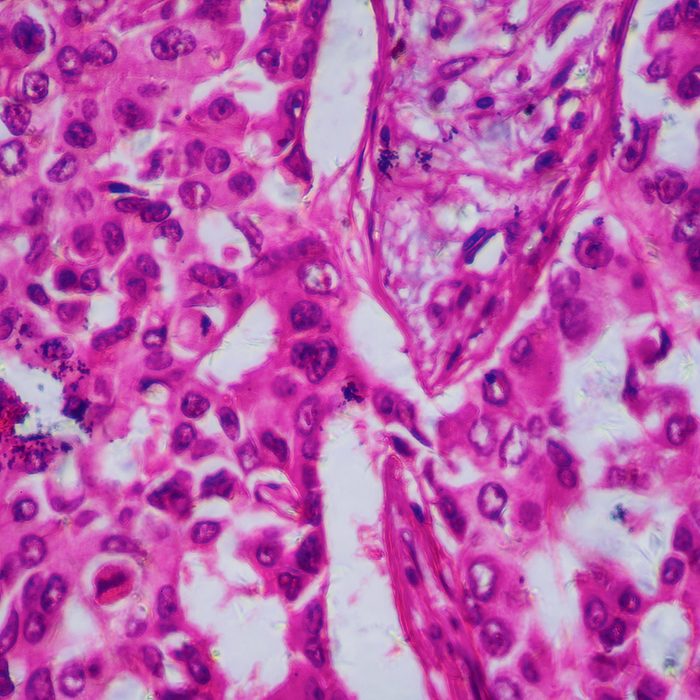
Every type of breast cancer is different, but inflammatory breast cancer possesses characteristics that can stand out. A doctor who specializes in understanding inflammatory breast cancer suggests catching this form of breast cancer early can help you get the best treatment possible.
The American Cancer Association explains inflammatory breast cancer, also known as “IBC,” doesn’t usually present as a lump and only accounts for 1% to 5% of all breast cancers.
Inflammatory breast cancer is a type of invasive ductal carcinoma that presents differently from other forms of breast cancer. Angela Alexander, PhD, senior clinical studies coordinator of the Inflammatory Breast Cancer Program at the University of Texas MD Anderson Cancer Center, tells The Healthy @Reader’s Digest: “Inflammatory breast cancer most often starts in the ducts, which are the vessels that carry the milk from the lobules to the nipple. These are the cells that more often divide, and therefore [are] most prone to accumulating genetic damage in genes that cause cancer.”
While each case can be unique, Dr. Alexander and the National Breast Cancer Foundation state that some main inflammatory breast cancer symptoms can include those listed below. “The speed of symptoms are a key part of making the diagnosis,” Dr. Alexander suggests.
Symptoms of inflammatory breast cancer
1. Redness
Inflammatory breast cancer can start with a redness on the skin, look perhaps similar to a small bug bite in the beginning. What can start as a small red spot can progress to take over a larger segment of the breast. “The amount of breast involvement is often one-third or more,” Dr. Alexander says.
9 Symptoms of Breast Cancer That Aren’t Lumps Every Woman Should Know
2. Swelling
“The most common symptoms of IBC are breast swelling and redness of the breast skin,” Dr. Alexander says.
The breast may also feel warm from the swelling. One breast may appear larger than the other due to inflammation. “The asymmetry is one of the first things that patients notice,” Dr. Alexander says. “It can start out feeling like one breast doesn’t fit in the bra like usual, but over a short time (days to weeks), the overt skin changes occur.”
Keep reading for more information on those skin changes.
3. Itching
The National Breast Cancer Foundation explains that in addition to a red, swollen breast, your breast may also itch as well. Dr. Alexander refers to itching as one of the “less common symptoms” of inflammatory breast cancer.
8 New Breast Cancer Treatments Some Oncologists Are Calling ‘Mind-Blowing’
4. Texture changes
As inflammatory breast cancer progresses, the skin can change to appear like orange peel and may also feel as though it’s thickened, Dr. Alexander says.
Other symptoms of inflammatory breast cancer
Another of the “less common symptoms” Dr. Alexander mentions is “the presence of a mass,” she says.
Some people have changes in the nipple, such as an inversion or “retraction,” where the nipple is flat or appears to go inward instead of directing outward.
Doctors Share What to Know About the New Changes for Breast Cancer Screenings
Other key insights on inflammatory breast cancer
Though inflammatory breast cancer is rare and often aggressive, there are multidisciplinary treatments that can boost survival, Dr. Alexander says. The National Breast Cancer Foundation notes that in recent years, survival rates have improved.
The earliest stage that inflammatory breast cancer is diagnosed is IIIIA, and 30% of patients are diagnosed at stage 4, which means the tumor cells already spread beyond the breast and regional lymph nodes. Stage 4 cancers have traditionally been generally incurable, Dr. Alexander says.
Treatment can be local (on the breast) or systemic (throughout the whole body). Testing for biomarkers such as ER, PR and HER2 is necessary to select the most effective systemic treatment, Alexander says.
Treatment for inflammatory breast cancer also can include chemotherapy, and radiation. Mastectomy is the required surgery in order to remove all the cancer and affected skin after chemotherapy, Dr. Alexander says.
The MD Anderson center notes that the five-year survival rate for inflammatory breast cancer is approximately 40%, but advances in care are improving that. Recent studies have shown that with the right treatment, the five-year survival rate is closer to 70% for stage 3 patients, and up to 50% for newly diagnosed stage 4 patients.
Doctors typically diagnose inflammatory breast cancer with a mammogram, ultrasound and a biopsy, Dr. Alexander says.
